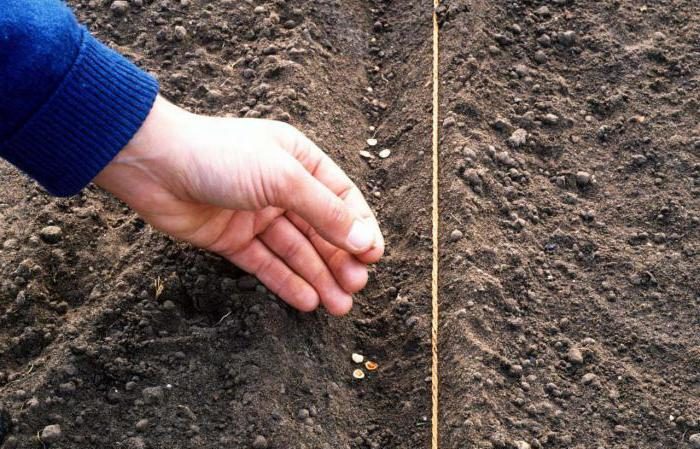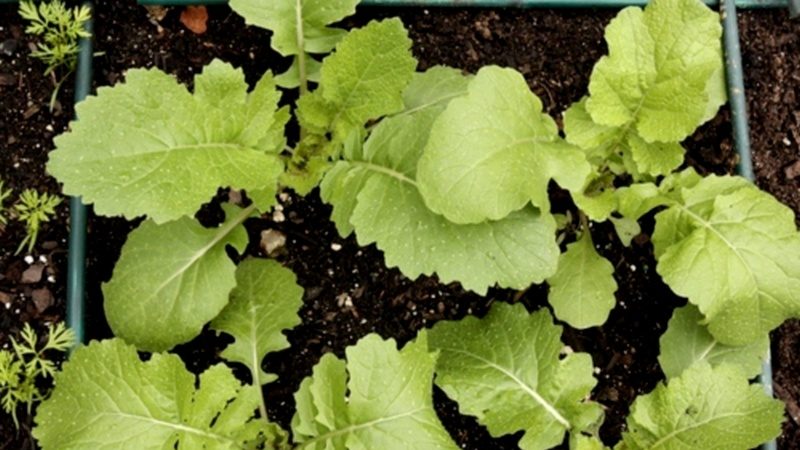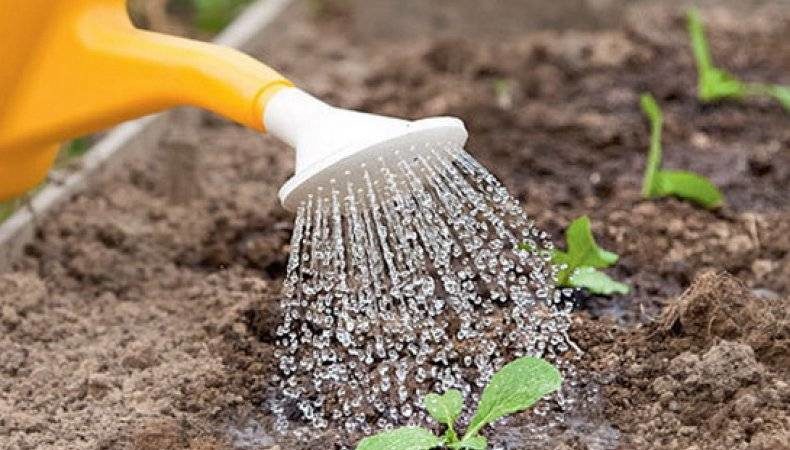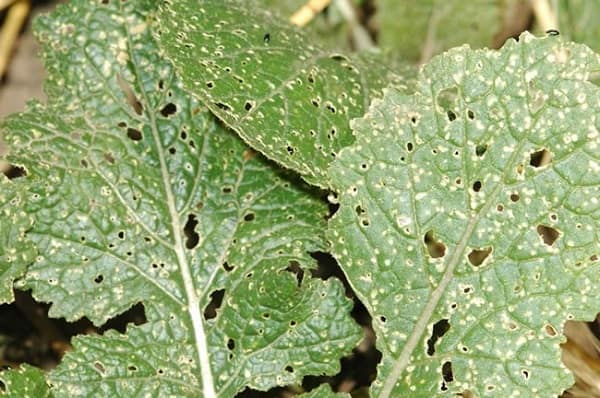Growing and caring for turnips in the open field
Turnip is an unpretentious and frost-resistant vegetable. The seeds germinate at an air temperature of -2 ° C, so the plant is successfully cultivated even in the northern regions. Consider the methods of growing turnips in the open field and the requirements that it makes for planting and care.
The content of the article
Growing turnips

Grow turnips seedling or sowing directly into the open ground. Average yield, subject to agrotechnical requirements - 3-4 kg per 1 m².
The crop is not planted after radish, cabbage, daikon, or radish. Suitable precursors are potatoes, tomatoes, cucumbers, corn, pumpkin, legumes, and squash.
How and how the turnip reproduces
It is a vegetable with a 2-year growing season that is propagated by seeds. In the first year after planting, the turnip forms roots with leaf rosettes, in the second it releases an arrow with flowers on which they ripen seed.
To obtain seeds, root crops with good varietal traits are selected and placed in storage. In the fall, the site is dug up and fertilized with humus, in the spring, re-digging is carried out and vegetables are planted in rows every 30–40 cm. The peduncle is tied to a support and, when the pod turns light yellow, the seeds are collected.
Reference. To obtain seeds, varieties intended for winter storage are used.
The planting material is peeled and dried. The seeds are dipped in a saline solution and disposed of floating specimens. The grains settled to the bottom are wrapped in a cloth for 5 minutes, immersed in hot (+ 40 ... + 50 ° C) water, and then in cold water for 2 minutes. After that, they are soaked for 20 minutes in a solution of potassium permanganate, washed, soaked for 2-3 days in water for swelling, and for a day in a solution of a growth stimulator ("Epine-extra", "Zirkone").
How to plant seeds in open ground
The timing of sowing seeds depends on the purpose of growing the turnip. With spring (April - May) sowing, the crop is harvested in the summer; for winter storage, the crop is planted in the summer (June - July). Podzimny (October - November) sowing is carried out for harvest in spring.
For planting, choose a place with peat, sandy loam or loamy soil, located on a plain or in a small lowland. The plot is dug up on a shovel bayonet in the fall and 2-3 kg of humus or compost, 10-15 g of nitrogen-phosphate and 15-20 g of potassium fertilizers per 1 m² are added.

Sowing rules:
- Prepare the beds in the selected area at a distance of 20–35 cm from each other.
- Every 10 cm, make planting furrows in them 1.5–2 cm deep.
- Place seeds in them at the rate of 0.2-0.3 g per 1 m².
- Cover the planting with sand, then with humus or loose soil.
- Water the area, cover the beds with polyethylene.
- Remove the covering material after 2 days.
To facilitate planting, the seeds are mixed with sand in advance or glued to a tape.
When sowing in winter, the seeds are buried 3-4 cm and sprinkled with peat or sand, not frozen soil. When the snow falls, it is thrown onto the beds, repeating the procedure 2-3 times per season.
Seedlings appear in a week or 3-5 days (if the air temperature is + 15… + 18 ° C). When the plants form 2 pairs of leaves, the seedlings are thinned out so that the distance between them is 6–10 cm.
Reference. The average planting density is up to 50 root crops per 1 m².
Plants are watered as the soil dries up at the rate of 20 liters of water per 1 m².
Growing through seedlings

Seeds for seedlings are sown in wooden containers or individual containers with a suitable substrate 6-8 weeks before transplanting seedlings into open ground.
Seedlings do not tolerate picking well, in which there is a risk of damage to the root system, so the best option is to sow seeds in peat tablets. They are pre-soaked, and after the peat mixture swells, 2-3 grains are placed in each.
The containers are covered with polyethylene and placed in a bright place protected from direct sunlight at a temperature of + 10 ... + 15 ° C.
After emergence, the film is removed, and the temperature is maintained within + 6 ... + 12 ° C. When the plants open the cotyledons, the seedlings are thinned out, getting rid of weak and non-viable specimens, cutting them off at the level of the soil surface.
Watering is carried out as the soil dries out, preventing it from drying out or waterlogging. After moistening, the substrate is gently loosened - this increases its moisture permeability and aeration.
4-5 days after the opening of the cotyledons, the plants are watered with a solution of "Nitrofoski" (1 tablespoon per bucket of water) at the rate of 10-15 ml per seedling.
Plants begin to harden 15–20 days before transplanting into open ground. For this, containers with seedlings are daily taken out into the street or balcony, first for an hour, gradually increasing this time so that in the last days the seedlings remain in the open air for a day.
Reference. When growing seedlings in peat tablets, the seedlings are transplanted into the beds with them.
When to plant outdoors? The culture is transferred to the site around mid-May. For this, beds are formed in the prepared area and planting holes are dug every 25–30 cm. Seedlings are removed from containers along with a lump of earth, placed in the center of the holes, sprinkled with soil, tamped and watered.
Turnip care outdoors
To get a bountiful harvest of succulent and large root crops, the plants are provided with competent care, which consists of watering, fertilizing, weeding and protecting from pests.
Watering

This is a moisture-loving culture... Prolonged drought negatively affects the quality of root crops - they begin to taste bitter and lose their juiciness. At the same time, an excess of moisture provokes the development of diseases and rotting of plants.
In the absence of regular rainfall, turnips are watered on average once every 3 days. Water consumption during germination of seedlings is 8–10 liters per 1 m², during the formation of root crops - 10–12 liters per 1 m².
Watering is carried out by sprinkling before sunrise or after sunset using warm, settled water.
Important! To prevent cracking of root crops, watering is reduced when they have grown enough in volume.
After moistening, the soil is mulched with straw or sawdust to retain fluid.
Weeding and loosening
After each watering or rain, the soil is loosened to eliminate the risk of a dry crust on its surface, which disrupts aeration, moisture permeability of the soil and provokes deformation of root crops. Weeds are removed at the same time.
Top dressing
The culture is fertilized 2 times per season:
- 4 weeks after germination, complex mineral fertilizers are applied (Nitroammofosku, superphosphate, potassium chloride or potassium magnesium);
- in the middle of summer - 250-300 g of wood ash per 1 m², watering with potassium sulfate solution (10 g per bucket of water).
If the soil is fertile enough, they do without additional fertilization.
Features of growing turnips in different regions
Due to the short (60–80 days) growing season, 2 turnip crops are grown per season. At the same time, planting dates vary depending on the region.
Spring sowing is carried out when the soil warms up to + 10 ... + 15 ° C. In central Russia and the Moscow region, this is most often the end of April - early May, in the Urals and Siberia - the first decade of May.In the summer in the Moscow region and the central part of Russia, they land in mid-July, in the northern regions - in early August.
The climatic conditions of the region also affect the care of plants. So, in the southern regions, characterized by hot and dry summers, watering is carried out more often than in the north.
Pests and the fight against them

Among pests, cruciferous fleas, cabbage flies, scoops, cabbage and turnip whites are the most dangerous.
Leaves in holes with a cruciferous flea
Cruciferous flea beetles are black, green or blue bugs up to 10 mm in size that feed on turnip greens, resulting in crop failure.
To prevent their appearance, weeding and autumn digging of the soil are regularly carried out, phytoncide plants (calendula, nasturtium, garlic, tomatoes, marigolds) are planted nearby, turnip planting dates and watering rules are observed.
What to do if the turnip leaves are in holes? To get rid of pests, the beds are sprayed with soap-herbal infusion (800 g of dry yarrow and 50-60 g of soap shavings per 10 l of water), vinegar solution (1 tablespoon of vinegar per 10-12 l of water) or potato broth (4 kg of tops per 10 liters of water). If folk methods do not help, use insecticides ("Karbofos" or "Actellik").
Scoop
The larvae of the pests feed on the green part and the pulp of the turnip root. To get rid of them, the plants are sprayed twice with an interval of 2 weeks with Eurodim or Akiba insecticides.
Cabbage fly
Cabbage fly larvae damage the roots and leaves of the crop. To combat pests, turnips are powdered with wood ash or tobacco dust, sprayed with "Karbofos" or "Topaz".
Cabbage and turnip white
Caterpillars eat the tops and damage the roots of the turnip. To combat pests, plantings are sprayed with soap-ash (2 tablespoons of ash and 1 tablespoon of liquid soap for 10-11 liters of water), onions (2 liters of husk for 2 liters of boiling water), tomato (2.5-3 kg tops of tomatoes for 5-5.5 liters of boiling water) infusions or insecticides ("Fitoverm", "Aktara").
Wireworms or clickers
Beetle larvae eat root vegetables, leave holes in the pulp. They get rid of insects by spraying the plantings with a solution of potassium permanganate or decoction of onion peels.
How turnip blooms

Regardless of the variety, the turnip is a juicy and fleshy root vegetable with a rosette consisting of large leaves and a stem 50–140 cm high with golden flowers.
At the beginning of flowering, the plant forms a corymbose inflorescence, which later becomes racemose, and the flowers are located on an elongated main axis. Peduncle 3–8 cm long is rejected at an acute angle, the flower consists of 4 cruciform cups, 4 petals, 2 short and 4 long androceae and 1 pistil.
Ripening and harvesting
The crop is harvested as soon as the roots reach a diameter of 6 cm or more. For winter storage, turnips are harvested in late September - early October.
Root crops are pulled out or dug up, the tops are cut, leaving a maximum length of 1 cm, cleaned from the ground, sorted and dried.
Vegetables are placed in wooden boxes, sprinkled with sand and stored in a dark room at a temperature of 0… + 3 ° C for 3 months. Turnips are stored in the refrigerator for a maximum of 1 month, at room temperature - 10-15 days.
It is interesting:
Does turnip with honey help cough and how to properly use such a medicine
Proven ways to properly store turnips for the winter
The best recipes for harvesting turnips for the winter from experienced housewives
Conclusion
Turnip is an unpretentious vegetable that even novice gardeners can cope with cultivation. Knowing how to properly grow a crop, it will be possible to get 2 harvests of root crops per season. The main thing is to observe the timing of sowing seeds, monitor the frequency of watering and not neglect preventive treatments of plantings from pests.